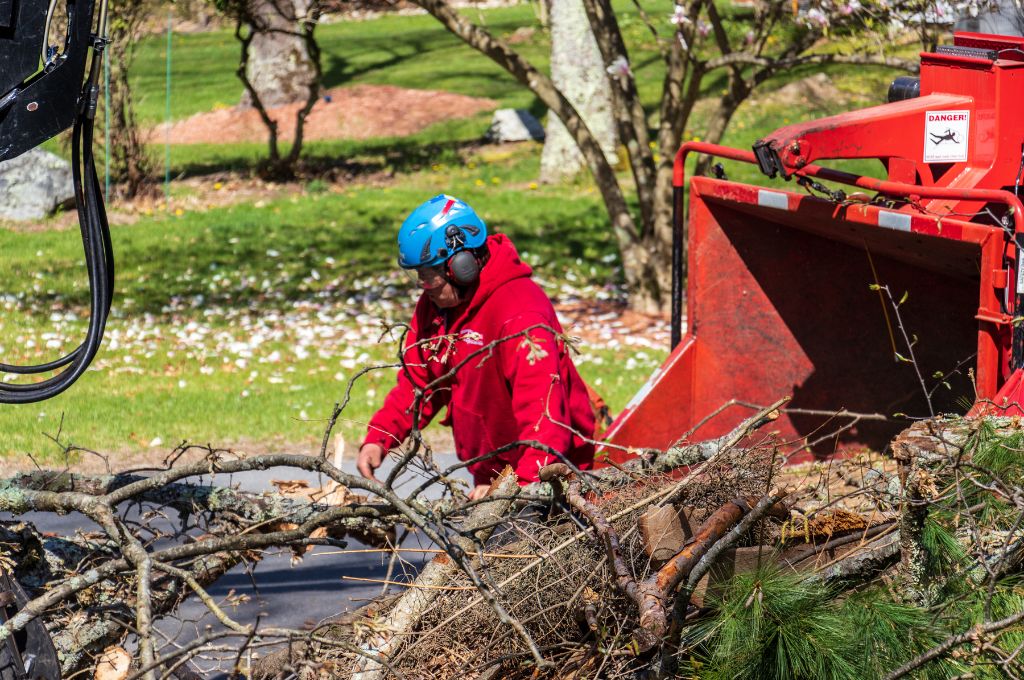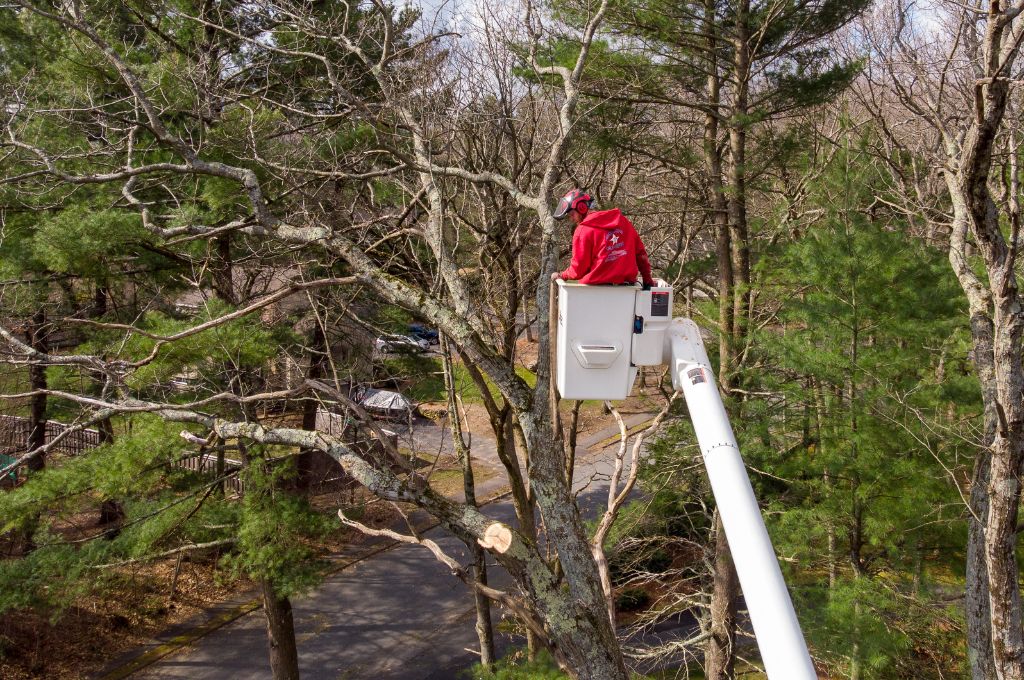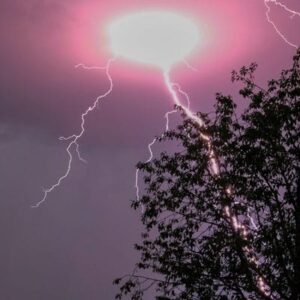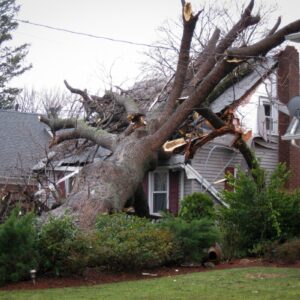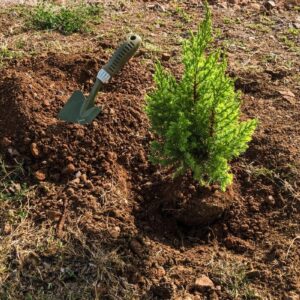The concept of trimming your trees seems simple, but when you get in the weeds, you soon realize there’s a lot more to it. Navigating the intricacies of tree trimming in the towns and cities of Massachusetts’ Metro West region can often seem like a journey through an uncharted wilderness.
Whether you’re puzzled about the right time for tree trimming, concerned about the safety of your trees near power lines, or curious about the difference between tree topping and canopy raising, this article serves as your definitive source for tree trimming FAQs. Drawing upon extensive expertise and a commitment to preserving the lush canopy that defines our area, we answer all your questions surrounding tree trimming in this comprehensive FAQ article.
What is tree trimming?
Tree trimming is the process of selectively removing branches from a tree to ensure healthy growth, maintain its desired shape and size, and enhance its aesthetic appeal. It’s primarily focused on the outer envelope of the tree to manage its structural integrity. Trimming is often performed to prevent branches from obstructing views, interfering with power lines, or creating hazards. Tree trimming can also help in thinning out overgrown branches, promoting a balanced and shapely growth that contributes to the overall landscape design and plant health.
Tree service professionals often distinguish “tree trimming” from “tree pruning”, with the term “pruning” used to refer to work done to remove dead, diseased, or damaged branches to improve the tree’s health or direct new, healthy growth. However, because most residents in the Metro West area use the term “tree trimming” to refer to any kind of branch cutting, we’ll use the two terms interchangeably in this FAQ article.
Why should I have my trees trimmed?
There are many reasons why tree trimming may be needed. In many cases, MetroWest area residents have safety concerns about their trees and request tree trimming to mitigate risks. Other common reasons include: enhancing tree health, improving its appearance, promoting a stronger and safer structure, proactively pruning branches to prevent future storm damage, increasing sunlight for rooftop solar panels, and maximizing fruit production.
Will trimming make my trees healthier?
Pruning trees for health reasons entails removing diseased or insect-infested wood, thinning the crown to enhance airflow and reduce pest problems, and eliminating crossing or rubbing branches. This type of pruning helps maintain the tree’s health, encourages strong structure development, and reduces the risk of damage during severe weather events.
What’s the best time of year to trim trees in Massachusetts?
When a tree should be pruned depends on many factors, including the tree species, its health, and your desired outcomes. However, you may be surprised to know that winter is an ideal season to trim most types of trees so it’s generally safe to plan on pruning during this timeframe.
A tree care professional will be able to tell you what timing works best for your particular trees.
What if my tree is ugly or lopsided – can trimming make it look better?
In many cases, yes! Tree trimming for aesthetics involves enhancing the natural form and character of trees, stimulating flower production, and improving the overall look of the tree. Proper pruning can help trees grow in a desired fashion, enhancing their appearance and visual appeal.
I’ve read that young trees should be regularly pruned. Why is that?
Pruning can help trees develop a strong structure, sturdier limbs, and a lush form, which is especially important for young and newly planted trees. By promoting proper growth patterns right from the beginning, trees will have greater structural integrity, will look better, and will live longer.
Once trees have matured, they typically only need trimming for maintenance purposes such as removing dead or diseased limbs, storm-damaged branches, or smaller limbs.
Do fruit trees, like apple trees, need special pruning?
If you want more and better-quality fruit on your trees, regular fruit tree trimming is the way to go. It can encourage fruit production by removing dead limbs that harbor pests and diseases, allowing for healthier growth of the spurs that are responsible for fruit production.
Can tree trimming protect my tree from Nor’easters and other storms?
Trimming trees can protect them from storm damage by reducing the presence of weak or damaged limbs that are prone to breaking during harsh weather conditions. Maintaining a strong, balanced tree through professional pruning can help prevent accidents and property damage during storms.
What is safety pruning?
Pruning for safety involves removing branches that could fall and cause injury or property damage, trimming branches that interfere with visibility on streets or driveways, and eliminating branches that grow into utility lines. Safety pruning aims to prevent accidents and hazards caused by weak or damaged branches.
How often should you trim your trees in Massachusetts?
How often a tree should be pruned varies based on the tree’s age, species, health, location, and other specific needs.
In general, young trees, especially those that are newly planted or under 20 feet in height, may require more frequent pruning to establish their structure and canopy size. This can range from annual pruning for some species to every 2 to 3 years for young trees.
Once a tree reaches maturity and has established its overall canopy shape, it’ll need less frequent pruning. Most mature trees of any variety can be trimmed every 3-5 years.
For example, oak trees are typically pruned every 2-3 years when young and every 3-5 years when older due to unique pruning needs related to oak wilt disease. In contrast, fruit trees often benefit from annual pruning to enhance fruit production, while evergreen trees can often go many years without needing pruning.
Why should I remove the lower branches on my tree?
Removing lower branches on a tree (called crown raising) can enhance its appearance, improve access and visibility, promote sunlight penetration for undergrowth, reduce maintenance efforts, and contribute to its structural integrity. But these benefits only occur when crown raising is done correctly and in moderation.
Is it okay to DIY trim my trees?
Unless it’s a small tree, trimming should be handled by professional tree care experts. This removes your risk of personal injury and reduces the chance of causing severe damage to your trees. Experienced professionals have the right knowledge, equipment, and skills to trim your trees safely and properly.
If I decide to trim my trees myself, are there any safety precautions I should take?
Safety should always come first. That means wearing the right safety gear, including safety glasses with side shields, a hard hat, gloves, a long-sleeved shirt, long pants, and steel-toed boots to protect yourself from potential hazards like falling branches and sharp tools.
Before starting work, check the area carefully for potential hazards such as unstable trees, weak branches, and animal hazards like bees or wasps. Be sure to also inspect tree stability, trunk condition, and limb health.
Never prune trees or branches within 10 feet of power lines to prevent the risk of electrocution. Avoid climbing trees in heavy winds, wet conditions, or icy weather as these conditions can make operations dangerous.
Most importantly, please do not climb large or tall trees or use a ladder to access the tree canopy. If you cannot reach the branches from the ground, the safest approach is to call a professional tree-trimming company with the experience and equipment to do the job safely.
Anything else I should consider before starting DIY tree trimming?
Homeowners are often surprised at the large volume of debris caused by pruning; those branches, twigs, and leaves take up a lot of space once they’re on the ground! Consider how you’re going to dispose of all that material before you start cutting your tree.
Will tree trimming harm my tree?
When handled by professionals, tree trimming does the opposite: it promotes better tree health by removing dead and/or diseased limbs.
Can pruning kill a tree?
Yes, pruning can potentially kill a tree if done improperly. Improper tree trimming practices, such as over-pruning, topping, lion-tailing, flush cuts, or trimming branches at the wrong time of year, can lead to a decline affecting the tree’s health and structural integrity.
What are the most common tree trimming mistakes and how can I avoid them?
Improper pruning practices, such as over-pruning, topping, lion-tailing, flush cuts, or pruning at the wrong time, can harm a tree’s health and structural integrity. For more details, see our article about tree trimming mistakes.
How can I tell if a tree has been trimmed incorrectly?
Besides the obvious signs, such as torn bark, branch stubs, flush cuts (cutting into the branch collar), heading cuts (cutting branches off at a random spot), and an overall uneven or unappealing shape, there will usually be signs that show up later. Longer-term signs of poor pruning include stunted growth, rot and decay, unusual growth patterns, and sunscald.
Can you save a tree that has tree improperly pruned?
Yes, a tree that has been improperly trimmed can potentially be saved through corrective pruning by an experienced tree pruning professional. With proper corrective pruning techniques and ongoing care, it is possible to mitigate the damage caused by improper pruning and help the tree recover. Corrective pruning may involve removing excess branches, shortening others, and guiding the tree back to a normal growth pattern over time.
How much can you trim off a tree without killing it?
You don’t want to remove more than 25% of the foliage from a tree in a single year. Removing too much foliage or too many branches at once could damage your tree beyond repair.
What happens if you trim a tree too much?
Over-pruning stresses the tree, reduces its ability to photosynthesize and store energy, weakens its defenses against pests and diseases, and in severe cases, can result in tree death.
What happens if you cut all the branches off a tree?
Most trees will die if you cut all their branches off, especially if you do it all at once. Without leaves to generate energy for the tree through photosynthesis, the tree will essentially starve to death.
My tree service company says they will not top trees. Why not?
Topping trees by cutting main branches back to stubs is highly discouraged as it weakens the tree and can lead to further issues. Topping disrupts the tree’s natural structure, forces weak new growth prone to breakage, and can cause decay.
Which parts of a tree should not be trimmed off?
The branch collar should not be cut off when pruning branches. These are the wide areas where branches connect to the trunk. These need to be kept intact to ensure your tree heals properly after being trimmed. Flush cuts that remove the branch collar can lead to wounds that don’t heal properly.
Does tree trimming actually help trees grow?
Yes. Tree trimming and pruning can encourage your tree to put out new growth. Think of trimming as providing the best possible structure for your trees to grow (when it’s handled correctly). Proper tree trimming helps balance the load weight of branches on a tree to help it grow well for years to come.
Can trimming save a half-dead tree?
There’s no clear answer for this question without examining the tree. It falls under “it depends” and is judged on a case-by-case basis. Contact us today to inspect your tree and determine whether it can be saved.
There are dead branches on my tree. Should I cut them off?
As a general rule, cutting off dead branches may help a tree, but every situation can be different. When done properly, cutting off a dead branch will allow the tree to focus on the healthy branches and promote more growth.
Can a tree with dead branches be saved by pruning them off?
Yes. Dead branches don’t equate to an entirely dead tree. Too many dead branches can indicate an issue, and problems may spread from tree branches all the way to the tree’s roots if left unchecked. You should get dead branches taken care of quickly.
Should I put paint or wound dressing on a cut branch?
No. Research has shown that painting cuts with wound dressing can actually interfere with the tree’s natural wound responses and can trap moisture inside the wound, potentially leading to more problems instead of preventing them. In fact, using black “wound dressing/tree paint” has been known to be harmful to trees for decades; just don’t do it! The best practice is to let the tree heal naturally through its own processes without the use of pruning paint or sealant.
Is there anything I should do to help my tree recover after it has been trimmed?
Pruning is stressful to trees, so it’s essential to ensure they are well-hydrated post-trimming, especially during dry periods. Provide adequate water to support new growth and consider adding suitable fertilizer for fruit trees to boost leafy growth.
How long does it take for a tree to recover after trimming?
Generally, trees have their own natural healing process where they grow new tissue over pruning wounds to create a barrier against disease and decay. The new growth typically stems from the branch collar, which is the swollen area of tissue on the tree trunk from which the branch grows.
For young trees, if pruning cuts are kept under ¾ inch, they can heal in a single growing season. However, for older plants that require corrective pruning, it may be more challenging to keep cuts small, and the healing process may take longer. In cases of bad pruning practices like topping trees or making large-diameter cuts outside the dormant season, recovery can be significantly delayed or compromised.
Looking for Professional Tree Trimming in Metro West MA?
The trimming experts at American Climbers, based in Southborough, MA, are here to help. You may have seen our crews trimming large trees in your neighborhood; we’ve been the preferred tree-trimming company in the region since 1996!
If your trees are too large, looking lopsided, full of deadwood or broken branches, blocking your view, or just getting out of control, call Metro West’s award-winning team of tree trimmers at 508-497-8628 today for a free quote.
Blog Topics
Recent Posts
What's Happening? Stay Informed!
Stay on top of local events, pest and disease updates, tree and landscape tips, and more. Delivered straight to your inbox each month.



